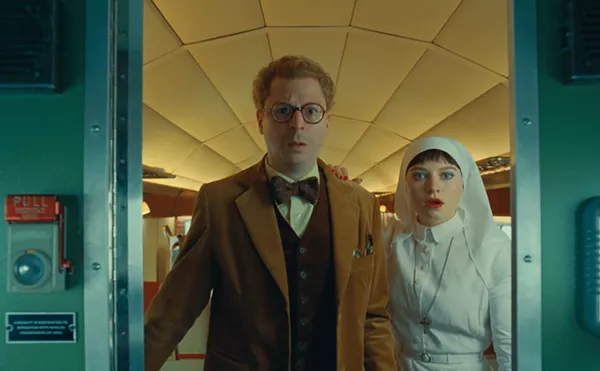When I tell you the Art and Culture Center of Hollywood's big summer show features the work of a Jack Russell terrier, you'll probably expect a string of dog puns: "It's the dog days of summer!" "The Art and Culture Center has gone to the dogs!" Well, you're barking up the wrong tree. (Sorry, I couldn't resist.)
But seriously, folks. This exhibition of canine shenanigans is being treated seriously, or so it seems. Maybe the whole enterprise is so deadpan, so tongue-in-cheek, that the joke's on me, not to mention everyone else who wastes time and money on it. If this is a put-on, it's one that's gotten way out of hand. (Village Voice art critic Jerry Saltz declares it "A sham.")
It starts with the title — "The Tillamook Cheddar Mid-Career Retrospective 1999-2009" — and continues with the posted introduction, credited to "F. Bowman Hastie III, assistant to Tillamook Cheddar." There's even an artist book, Portrait of the Dog as Young Artist, for sale in the lobby.
And of course, there's an artist bio, which I will let speak for itself: "Tillamook Cheddar is a 10-year-old Jack Russell Terrier who is widely regarded as the world's preeminent canine artist, using a dynamic color transfer technique to create her work. 'Tillie' has had 17 solo exhibitions in the United States and Europe and has been featured in press and television worldwide." Parade magazine, that bastion of cultural commentary, once named Tillie as Best New Artist.
As for that "dynamic color transfer technique," it boils down to this: Hastie puts carbon paper or transfer paper beneath the paws of the dog, who scratches out her "work," sometimes supplementing the claw marks by biting or tearing the paper with her teeth. The results, literally dozens and dozens of them, are on display on the walls of the center's main gallery.
Needless to say, there's not much variety, even though Tillie and her handler use an array of colored papers. Hence the need to flesh out the show with other items. There are display cases featuring, for instance, five well-chewed baseballs and video monitors showing the "artist" at work. One wall includes "collaborations" between Tillie and other artists. A table in the center of the gallery serves as a sort of resource center, overflowing with the miraculous mutt's press clippings.
There are also portraits of the artist in various media by other artists, some of which aren't bad. Derek Buckner's oil-on-wood Tillie, for example, could be favorably compared with the work of Lucian Freud. And Dirk Westphal's Tillie on Blue is an appealingly straightforward C-print.
But to address a nagging question, do Tillie's scratchings and bitings add up to art? Not to my way of thinking, and here's why. To qualify as a work of art, at least in these postmodern times, a thing must be created with intent, and animals are not capable of intent in the same way humans are. To cite one infamous example, intent was what allowed Marcel Duchamp to turn a men's urinal on its side, sign it R. Mutt (!), present it with the title Fountain — and have it accepted (if begrudgingly) as art. Tillie's creations, by contrast, may be diverting cultural artifacts, but they are not art.
There is, however, some real art on display in the center's long, narrow middle gallery, which is devoted to a supplementary show called "It's a Dog's Life: Works From Francie Bishop Good and David Horvitz — the Dog Room Collection." Good and Horvitz know a thing or two about art: She's a gifted artist herself, and they're both collectors whose world-class collection of contemporary art is the source of a fine exhibition now on view at the Museum of Art/Fort Lauderdale.
For this playful, much less self-serious adjunct to the silliness of Tillie, they have raided the walls of their home gym and come up with a variety of dog-related art in several media to share. There are big C-prints by Good, for instance, along with a trio of acrylic dog portraits by another local talent, Wilma Bulkin Siegel. Not surprisingly, given the breadth and depth of the Good/Horvitz collection, there are also works by such national names as Tony Mendoza, Mary Ellen Mark, and William Wegman, he of the famous Weimaraner photographs — dog art, in other words, of an entirely different order.
Finally, in the Art and Culture Center's tiniest gallery, there is a mini-exhibition of half a dozen large charcoal drawings called "Virginia Fifield: The Pneumatikos Series." Unlike Tillie, Fifield, whose graceful charcoals of flowers and other animals have graced at least a couple of other local group shows in the past year, is the genuine article. Every one of her works here is a winner, especially a side view of a large black dog whose eye seems uncannily human. Gazing on her lovely work, I could understand why the artists I know who have visited "The Tillamook Cheddar Mid-Career Retrospective" see the show as an affront — a waste of gallery space that might otherwise be filled with real art by real artists.







